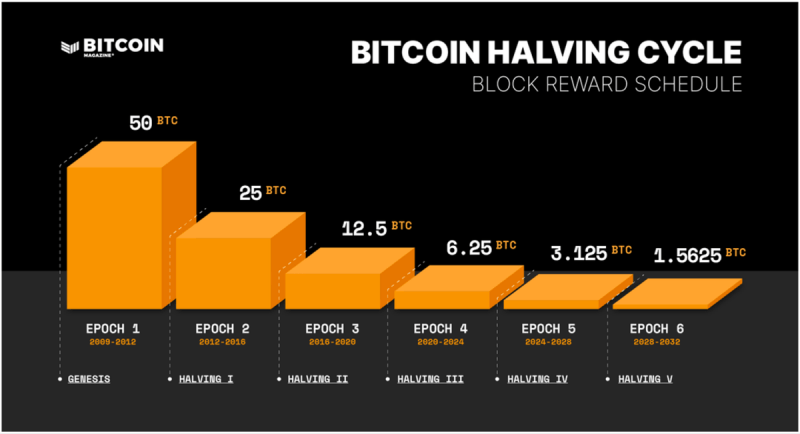Bitcoin Blockchain
When is the next Bitcoin Halving?
Introduction
As we approach the conclusion of the third epoch, the countdown to the next Bitcoin halving is firmly underway. The halving (also known as the “Halvening”) is one of the most important and innovative features of Bitcoin. Every 10 minutes, the Bitcoin network issues new bitcoin and approximately every four years (every 210,000 blocks, to be precise) the amount issued (the “block subsidy”) is cut in half. The block subsidy is the reward miners receive for validating and recording new transactions on the blockchain.
The halving of the block subsidy is a critical factor in bitcoin’s eventual capped supply of 21 million bitcoin. In addition, miners also collect transaction fees that users attach to their transactions to encourage miners to include them in the next block. Therefore miners often earn more bitcoin for mining a block than just the subsidy. .
WHEN IS THE NEXT BITCOIN HALVING?
The next Bitcoin halving is anticipated to take place on or around April 20, 2024 EST, reducing the block reward from 6.25 to 3.125 BTC. This halving period — or epoch — will increase the supply by 164,250 bitcoin (from 19,687,500 to 20,671,875), a mere 328,124 bitcoin from the maximum supply limit of 21 million.
TO CALCULATE THE NEXT HALVING DATE
- Determine the block interval: While it’s true that Bitcoin’s block time (the time between each block) is approximately 10 minutes, the time can vary slightly due to hash rate and network adjustments.
- Find the current block height: You need to know the current block height, which you can find on various blockchain explorer websites or directly from your Bitcoin node if you’re running one.
- Calculate the blocks remaining until the next halving: Bitcoin’s halving occurs every 210,000 blocks. Subtract the current block height from the next halving block height.
- Calculate the estimated time remaining: Multiply the number of blocks remaining by the approximate block interval (in seconds) to estimate the time remaining until the next halving.
- Convert the time into a date: Convert the estimated time remaining into a date format to find out when the next halving is expected.
Current block height: can be found here.
Block time: can be found here.
Current date: xx/xx/xxxx
Blocks per epoch: 210,000
Next halving block height: 210,000 times next halving number
Calculation:
(((Next Halving Block Height – Current Block Height)*10)/60)/24 = Days remaining
Hash rate and difficulty adjustment are two variables which constantly shape the speed at which blocks are processed and therefore the intervals between blocks. The date of the next halving can vary as a result, so it’s important to keep running the calculation.
HISTORY OF BITCOIN HALVINGS
As of March 2024, there have been three Bitcoin halvings:
- On November 28, 2012, Bitcoin’s block subsidy decreased from 50 BTC per block to 25 BTC per block.
- On July 9, 2016, the second Bitcoin halving decreased the block subsidy from 25 BTC per block to 12.5 BTC per block.
- On May 20, 2020, the third Bitcoin halving reduced the block subsidy from 12.5 BTC per block to 6.25 BTC per block.
BITCOIN HALVING 2012
The 2012 halving was Bitcoin’s first halving.
Halving:
Date: November 28, 2012
Halving number: 01
Block height: 210,000
Block reward: 25
Mined supply: 10,500,000 (amount of bitcoin already issued when the halving occurred)
Epoch:
Subsidy: 5,250,000
Percentage of mined supply: 25%
BITCOIN HALVING 2016
The 2016 halving was Bitcoin’s second halving.
Halving:
Date: July 9, 2016
Halving number: 01
Block height: 420,000
Block reward: 12.5
Mined supply: 15,750,000 (amount of bitcoin already issued when the halving occurred)
Epoch:
Subsidy: 2,625,000
Percentage of mined supply: 12.5%
BITCOIN HALVING 2020
The 2020 halving was Bitcoin’s third halving.
Halving:
Date: May 20, 2020
Halving number: 03
Block height: 630,000
Block reward: 6.25
Mined supply: 18,375,000 (amount of bitcoin already issued when the halving occurred)
Epoch:
Subsidy: 1,312,500
Percentage of mined supply: 6.25%
BITCOIN HALVING 2024
The 2024 halving will be Bitcoin’s third halving.
Halving:
Date: April 20, 2024 (estimated)
Halving number: 04
Block height: 840,000
Block reward: 3.125
Mined supply: 19,687,500 (amount of bitcoin issued when the halving occurred)
Epoch:
Subsidy: 656,250
Percentage of mined supply: 3.125%
FUTURE BITCOIN HALVINGS
The blocktime variable will introduce some variance in estimated halving dates, but it is possible to project approximate dates until the conclusion of block subsidies in 2140. Below, we provide a succinct overview of anticipated halving dates from 2024 to 2060, offering valuable insights into these upcoming milestones.
| Epoch Number | Block height | Halving Year | Estimated Halving Date |
|---|---|---|---|
|
04 (of 32) |
840,000 |
2024 |
April 20, 2024 |
|
05 (of 32) |
1,050,000 |
2028 |
2028 |
|
06 (of 32) |
1,260,000 |
2032 |
2032 |
|
07 (of 32) |
1,470,000 |
2036 |
2036 |
|
08 (of 32) |
1,680,000 |
2040 |
2040 |
|
09 (of 32) |
1,890,000 |
2044 |
2044 |
|
10 (of 32) |
2,100,000 |
2048 |
2048 |
|
11 (of 32) |
2,310,000 |
2052 |
2052 |
|
12 (of 32) |
2,520,000 |
2056 |
2056 |
|
(cont…) |
HISTORICAL IMPLICATIONS OF THE BITCOIN HALVING
Halving events have consistently preceded significant increases in bitcoin’s price, making them a focal point for market analysts.
Price Appreciation
Historically, bitcoin’s price has experienced significant upswings following halving events due to the combination of reduced supply and increased demand. These events substantially influence the overall supply of bitcoin, thereby affecting its price. Nevertheless, it is essential to acknowledge that the price dynamics are influenced by many factors beyond halving events.
- After the 2012 halving, the bitcoin price rose approximately 9,000% to $1,162.
- After the 2016 halving, the bitcoin price rose approximately 4,200% to $19,800.
- After the 2020 halving, the bitcoin price rose approximately 683% to $69,000.
Bitcoin issuance rate gets reduced in half roughly every four years.
Challenges for Miners
Halving events can pose challenges for miners, as their income decreases when block rewards are cut in half. To remain competitive, miners must operate efficiently, potentially driving the development and adoption of more energy-efficient mining technology. It is quite common for miners to go bankrupt, which often impacts the network’s hash rate, the supply of available for-sale bitcoin, and ultimately bitcoin’s price. Through the upheaval, the difficulty adjustment eventually restores equilibrium and the Bitcoin network and ecosystem continues to march forward.
FAQs:
Will Bitcoin go up at the halving?
Bitcoin’s historical performance after a halving event has shown a remarkable upward trajectory. The reduction in the rate of new supply is Bitcoin’s path to absolute scarcity. This event often sparks increased interest and demand. However, it’s vital to exercise caution and not view the halvings as guaranteed paths to quick profits. The prudent approach is to understand the long-term potential of bitcoin and consider it as a store of value rather than attempting to time the market with buying and selling.
Is Bitcoin halving bullish?
The Bitcoin halving is unquestionably a bullish event, as it shifts the supply dynamics in favor of price appreciation. While the halving is generally seen as a bullish event, it’s wise to remember that bitcoin’s price is influenced by several factors. Caution is advised.
How many days after Bitcoin halving does it hit its peak?
A look at the past three halving events shows that a significant price rise usually begins within a few months of the halving event. Also, before a halving event, the price of bitcoin tends to rise as investors anticipate a price rally post-halving. After the halving, the price usually takes over 12 months to reach its peak.
Should you buy bitcoin before the halving?
Instead of trying to understand when to buy and sell bitcoin, it’s advisable to understand the value of the asset. That said, a pattern has played out in the past where buying 6-12 months before the halving and selling 12-18 months after the halving tends to return a sizable profit. Past performance and behavior is not a guarantee of future performance. Our best advice to those who are not experienced traders would be to buy and hold for many cycles.
Link to source





